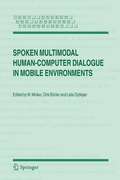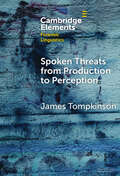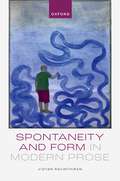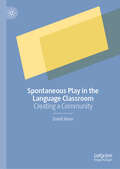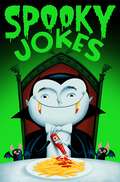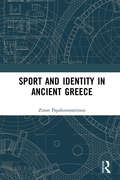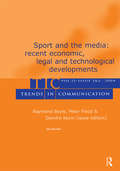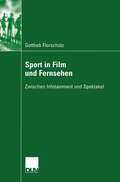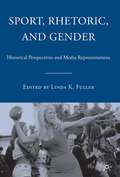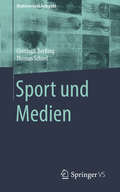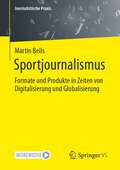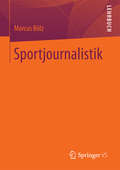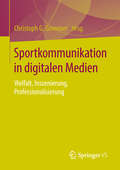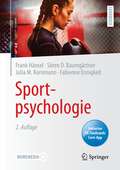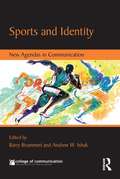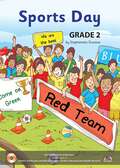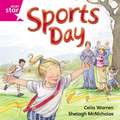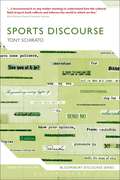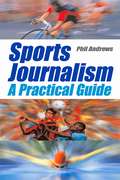- Table View
- List View
Spoken Multimodal Human-Computer Dialogue in Mobile Environments (Text, Speech and Language Technology #28)
by Dirk Bühler Laila Dybkjær Wolfgang MinkerThis book is based on publications from the ISCA Tutorial and Research Workshop on Multi-Modal Dialogue in Mobile Environments held at Kloster Irsee, Germany, in 2002. The workshop covered various aspects of devel- ment and evaluation of spoken multimodal dialogue systems and components with particular emphasis on mobile environments, and discussed the state-- the-art within this area. On the development side the major aspects addressed include speech recognition, dialogue management, multimodal output gene- tion, system architectures, full applications, and user interface issues. On the evaluation side primarily usability evaluation was addressed. A number of high quality papers from the workshop were selected to form the basis of this book. The volume is divided into three major parts which group together the ov- all aspects covered by the workshop. The selected papers have all been - tended, reviewed and improved after the workshop to form the backbone of the book. In addition, we have supplemented each of the three parts by an invited contribution intended to serve as an overview chapter.
Spoken Threats from Production to Perception (Elements in Forensic Linguistics)
by null James TompkinsonSpoken threats are a common but linguistically complex language crime. Although threatening language has been examined from different linguistic perspectives, there is limited research which critically addresses how people perceive spoken threats and infer traits such as threat and intent from speakers' voices. There is also minimal linguistic research addressing differences between written and spoken threats. By specifically analysing threats delivered in both written and spoken modalities, as well as integrating perceptual phonetic analysis into discussions on spoken threats, this Element offers perspectives on these two under-researched areas. It highlights the dangers of assuming that the way in which someone sounds correlates with, for example, their intention to commit harm, and explores potential problems in assuming that written and spoken threats are equivalent to one another. The goal of the Element is to advance linguistic knowledge and understanding around spoken threats, as well as promote further research in the area.
Spontaneity and Form in Modern Prose
by Vidyan RavinthiranThis study analyzes post-Romantic prose whose authors—in terms of race, gender, class, nationality, and more—occupy a range of subject-positions. Unlike poetry, modern literary prose has no rhetorical repertoire or structure (beyond those of grammar) that one could tabulate. As a result, it becomes a zone of experimentation and spontaneous creativity, as well as a means to investigate the concept of spontaneity, understood as post-secular. Heeding separate histories and peculiar particularities, this volume reveals writers discovering their ideas as they go, in prose whose sound, rhythm, syntax, and imagery escapes the preordained. There are chapters on William Hazlitt, Ralph Waldo Emerson and Walt Whitman (and Hindu philosophy), Gerard Manley Hopkins, Herman Melville, D.H. Lawrence and Saul Bellow, Virginia Woolf and Marion Milner, Gwendolyn Brooks, Adil Jussawalla, and Chimamanda Ngozi Adichie. These writers are intelligently vexed by two transitions: first, the movement from impulse into form; and second, the overlap between literary forms and social forms. They explore the yearning for renovated societies which, expressive of our deepest selves, would also enable those selves—in times of panicked fragmentation, moral relativism, and communication imperiled—to interact as citizens.
Spontaneity and Form in Modern Prose
by Vidyan RavinthiranThis study analyzes post-Romantic prose whose authors—in terms of race, gender, class, nationality, and more—occupy a range of subject-positions. Unlike poetry, modern literary prose has no rhetorical repertoire or structure (beyond those of grammar) that one could tabulate. As a result, it becomes a zone of experimentation and spontaneous creativity, as well as a means to investigate the concept of spontaneity, understood as post-secular. Heeding separate histories and peculiar particularities, this volume reveals writers discovering their ideas as they go, in prose whose sound, rhythm, syntax, and imagery escapes the preordained. There are chapters on William Hazlitt, Ralph Waldo Emerson and Walt Whitman (and Hindu philosophy), Gerard Manley Hopkins, Herman Melville, D.H. Lawrence and Saul Bellow, Virginia Woolf and Marion Milner, Gwendolyn Brooks, Adil Jussawalla, and Chimamanda Ngozi Adichie. These writers are intelligently vexed by two transitions: first, the movement from impulse into form; and second, the overlap between literary forms and social forms. They explore the yearning for renovated societies which, expressive of our deepest selves, would also enable those selves—in times of panicked fragmentation, moral relativism, and communication imperiled—to interact as citizens.
Spontaneous Play in the Language Classroom: Creating a Community
by David HannThis book investigates the importance of humour and play in the establishment of individual and group identities among adult language learners on an intensive business English course. The enclosed setting allows the emergent nature of community building and identity projection to be traced, foregrounding the important role of humorous play in these vital social processes. The book will be of interest to students and researchers of applied linguistics, second language acquisition and humour studies.
Spooky Jokes
by Macmillan Children's BooksOver 200 hilarious and wacky spooky jokes to get you ready for Halloween! The perfect (trick or) treat to read every year.What do mummies like listening to on Halloween? Wrap music.Which plant likes Halloween the most? Bam-BOO.What kind of pets do ghosts have?Scaredy-cats!
Sport and Identity in Ancient Greece
by Zinon PapakonstantinouFrom the eighth century BCE to the late third century CE, Greeks trained in sport and competed in periodic contests that generated enormous popular interest. As a result, sport was an ideal vehicle for the construction of a plurality of identities along the lines of ethnic origin, civic affiliation, legal and social status as well as gender. Sport and Identity in Ancient Greece delves into the rich literary and epigraphic record on ancient Greek sport and examines, through a series of case studies, diverse aspects of the process of identity construction through sport. Chapters discuss elite identities and sport, sport spectatorship, the regulatory framework of Greek sport, sport and benefaction in the Hellenistic and Roman world, embodied and gendered identities in epigraphic commemoration, as well as the creation of a hybrid culture of Greco-Roman sport in the eastern Mediterranean during the Roman imperial period.
Sport and Identity in Ancient Greece
by Zinon PapakonstantinouFrom the eighth century BCE to the late third century CE, Greeks trained in sport and competed in periodic contests that generated enormous popular interest. As a result, sport was an ideal vehicle for the construction of a plurality of identities along the lines of ethnic origin, civic affiliation, legal and social status as well as gender. Sport and Identity in Ancient Greece delves into the rich literary and epigraphic record on ancient Greek sport and examines, through a series of case studies, diverse aspects of the process of identity construction through sport. Chapters discuss elite identities and sport, sport spectatorship, the regulatory framework of Greek sport, sport and benefaction in the Hellenistic and Roman world, embodied and gendered identities in epigraphic commemoration, as well as the creation of a hybrid culture of Greco-Roman sport in the eastern Mediterranean during the Roman imperial period.
Sport and the Media: Recent Economic, Legal, and Technological Developments:a Special Double Issue of trends in Communication
by Raymond Boyle Peter Flood Deirdre KevinSport and the Media examines how reliable sportscasting is in the anchor role, reviews the development of sportscasting and specialized sporting services as a response to audience demand, and questions how well the sporting enthusiast--the fan--is being served by later, unanticipated developments. While sport has had a long symbiotic relationship with communication systems, the advent of a digital media age has intensified that relationship, giving evidence of both continuity and substantial change in this relationship as both media systems and popular culture have entered a new century. Collectively, the articles give an authentic flavor of the issues--real and incipient--surrounding sports broadcasting, the media, and the audience as the next round of media consolidation and investment appears to be starting. In particular, they pose questions as to whether sports as a 'killer application' has actually encountered some natural limit, and whether the audience at-large has been well served within the more recent developments.
Sport and the Media: Recent Economic, Legal, and Technological Developments:a Special Double Issue of trends in Communication
by Raymond Boyle;Peter Flood;Deirdre KevinSport and the Media examines how reliable sportscasting is in the anchor role, reviews the development of sportscasting and specialized sporting services as a response to audience demand, and questions how well the sporting enthusiast--the fan--is being served by later, unanticipated developments. While sport has had a long symbiotic relationship with communication systems, the advent of a digital media age has intensified that relationship, giving evidence of both continuity and substantial change in this relationship as both media systems and popular culture have entered a new century. Collectively, the articles give an authentic flavor of the issues--real and incipient--surrounding sports broadcasting, the media, and the audience as the next round of media consolidation and investment appears to be starting. In particular, they pose questions as to whether sports as a 'killer application' has actually encountered some natural limit, and whether the audience at-large has been well served within the more recent developments.
Sport in Film und Fernsehen: Zwischen Infotainment und Spektakel
by Gottlieb FlorschützGottlieb Florschütz gibt einen Überblick über die gesamte Sportfilmproduktion von den Anfängen in den 1940er Jahren bis zur Gegenwart, kategorisiert typische Erzählmuster des Sportfilms und stellt den engen Bezug zwischen Sportfilm, Sportfernsehen und Werbefernsehen her.
Sport, Rhetoric, and Gender: Historical Perspectives and Media Representations
by L. FullerInterested in the nexus between sport, gender, and language, Sport, Rhetoric, and Gender: Historical Perspectives and Media Representations contains 21 wide-ranging chapters examining sport vis-à-vis the language surrounding and incorporated by it in the world arena.
Sport und Medien (Medienwissen kompakt)
by Christoph Bertling Thomas SchierlSind Sportjournalisten unkritisch? Sind sie nur Fans, die es über die Absperrung geschafft haben? Warum gelingt es der Mehrzahl der Sportarten trotz aller Mühen nicht, in der Berichterstattung präsenter zu sein? Welche Macht kommt Amazon & Co. in Zukunft zu?Dies sind nur einige Fragen, die die Sportwelt beschäftigen. Der vorliegende Band widmet sich den Beziehungen von Sport und Medien, den Besonderheiten des Medieninhalts Sport und den Spannungsfeldern, die den Sportjournalismus von Anfang an begleiten und zukünftig zu großen Entscheidungen zwingen werden.
Sportjournalismus: Formate und Produkte in Zeiten von Digitalisierung und Globalisierung (Journalistische Praxis)
by Martin BeilsDer Band ist ein praxisorientiertes Lehrbuch für den Sportjournalismus. Im Vordergrund steht der Online-Journalismus. Schwerpunkte sind besondere Formate und Produkte, die den Sport von anderen Ressorts unterscheiden. Hier wird an konkreten Beispielen aus führenden Medien erklärt, wie sie erstellt werden, welche Besonderheiten zu beachten sind und wo Tücken lauern. Eine Einordnung des Sportjournalismus findet zu Beginn über einen Branchenüberblick statt. Außerdem werden Wege für Nachwuchskräfte in den Beruf skizziert. Den Wunsch nach einem kompakten, praxisorientierten Lehrwerk kennt der Autor aus seiner beruflichen Praxis: sowohl in Redaktionen als auch im Lehrbetrieb. Das Buch erklärt zum Beispiel, mit welchen Konzepten und welchen gleichsam handwerklichen Fertigkeiten es möglich ist, den Bericht über ein Fußballspiel mit dem Schlusspfiff – den sogenannten Schnellschuss – fertiggestellt zu haben. Hinzu kommen jeweils Tipps von anerkannten Expertinnen und Experten sowie eine Übung pro Abschnitt.
Sportjournalistik
by Marcus BölzDer Band bereitet die systematisch und empirisch fundierten Ergebnisse der Sportjournalistik didaktisch auf: Wie die Arbeit der Sportjournalisten konkret aussieht, welche Rahmenbedingungen diese Arbeit prägen und wie Akteure und Rezipienten sportjournalistische Medientexte herstellen, distribuieren und rezipieren. In dem Buch werden dazu die wichtigsten Modelle, Theorien und wissenschaftlichen Befunde dargelegt, anhand von Beispielen der Transfer der Inhalte vom Theoretischen zum Anschaulich-Praktischen vollzogen und die Inhalte und Positionen kritisch reflektiert.
Sportkommunikation in digitalen Medien: Vielfalt, Inszenierung, Professionalisierung
by Christoph G. GrimmerUnter den Perspektiven Vielfalt, Inszenierung und Professionalisierung analysieren Wissenschaftler und Praxisexperten aktuelle Potentiale und Herausforderungen im Bereich digitaler Sportkommunikation. Die Autorinnen und Autoren werfen einen Blick auf verschiedene Sportarten, Nutzergruppen bzw. Kontexte. Nach einer Einführung zur Rolle Sozialer Medien im Sport widmen sich weitere Beiträge der Vielfalt des PR-Einsatzes im Basketball und österreichischen Profifußball. Der Schwerpunkt des Buches liegt auf der Perspektive Inszenierung und fokussiert die darstellerischen Möglichkeiten für u.a. Prominente, Olympioniken und Journalisten. Mit 360 Grad-Videos wird eine bislang in der Wissenschaft weitgehend ausgeblendete Innovation der Social Media-Kommunikation aufgegriffen. Im dritten Teil erhält der Leser vertiefende Einblicke in die durch Soziale Medien beeinflusste Öffentlichkeitsarbeit von Pressesprechern und Kommunikationsagenturen.
Sportpsychologie
by Frank Hänsel Sören D. Baumgärtner Julia M. Kornmann Fabienne EnnigkeitDiese Neuauflage des kompakten Lehrbuchs der Sportpsychologie bietet Studierenden der Sportwissenschaft wie auch der Psychologie einen optimalen Überblick. Grundlegende Fragestellungen und Themen der Sportpsychologie werden kompakt und gut verständlich erklärt. Da sich die Sportpsychologie ganz grundsätzlich mit dem menschlichen Erleben und Verhalten in sportlichen Situationen beschäftigt, werden Fragestellungen aus einem breiten Spektrum aufgegriffen. Die Antworten basieren auf der aktuellen Forschung und weisen beispielhaft auf Anwendungen für die Sportpraxis hin. Das Lehrbuch ist hilfreich zur Prüfungsvorbereitung und ein Lesegenuss für alle, die an den wissenschaftlichen Grundlagen der Sportpsychologie interessiert sind. Dazu bietet die inkludierte Flashcard App digitale Frage- und Antwortkarten zum Selbsttest. Zusätzlich finden Sie digitale Zusatzmaterialien auf der Lehrbuch-Begleitwebseite.
Sports and Identity: New Agendas in Communication (New Agendas in Communication Series)
by Barry Brummett Andrew IshakThis volume of essays examines the ways in which sports have become a means for the communication of social identity in the United States. The essays included here explore the question, How is identity engaged in the performance and spectatorship of sports? Defining sports as the whole range of mediated professional sports, and considering actual participation in sports, the chapters herein address a varied range of ways in which sports as a cultural entity becomes a site for the creation and management of symbolic components of identity. Originating in the New Agendas in Communication symposium sponsored by the University of Texas College of Communication, this volume provides contemporary explorations of sports and identity, highlighting the perspectives of up-and-coming scholars and researchers. It has much to offer readers in communication, sociology of sport, human kinetics, and related areas.
Sports and Identity: New Agendas in Communication (New Agendas in Communication Series)
by Barry Brummett Andrew W. IshakThis volume of essays examines the ways in which sports have become a means for the communication of social identity in the United States. The essays included here explore the question, How is identity engaged in the performance and spectatorship of sports? Defining sports as the whole range of mediated professional sports, and considering actual participation in sports, the chapters herein address a varied range of ways in which sports as a cultural entity becomes a site for the creation and management of symbolic components of identity. Originating in the New Agendas in Communication symposium sponsored by the University of Texas College of Communication, this volume provides contemporary explorations of sports and identity, highlighting the perspectives of up-and-coming scholars and researchers. It has much to offer readers in communication, sociology of sport, human kinetics, and related areas.
Sports Day class 2 - MIE
by Stephanette Ducasse"Sports Day," a vibrant big book by Stephanette Ducasse, captures the spirited atmosphere at Happy Kids School during their annual sports event. The narrative unfolds as students participate in various lively activities and races, cheered on by enthusiastic parents and teachers. From the rabbit-race to the clothing-relay, potato-race, and more, each grade level engages in different games, fostering an air of excitement and camaraderie. As the day progresses, the anticipation heightens until the sports-teacher finally announces the victorious Red Team, igniting cheers and applause among the participants. With engaging illustrations and a dynamic storyline, this book not only celebrates the joy of sports but also encourages young readers to embrace teamwork, sportsmanship, and the thrill of competition in a school setting. Through its interactive sessions and activities, the book aims to enhance literacy skills while relaying the fun and energy of Sports Day at the school.
Sports Day (Rigby Rocket Independent #Pink Reader, Book 9)
by Celia WarrenThe children have fun on Sports Day
Sports Day (Rigby Rocket Independent #Pink Reader 9)
by Celia WarrenThe children have fun on Sports Day
Sports Discourse (Bloomsbury Discourse)
by Tony SchiratoThis book both defines sports discourse, and provides an account of the different discourses that are utilized and come into play when the field of sport speaks. It shows how the sports communities have been addressed over time by various speakers, across various multimodal genres. Tony Schirato looks first at how discourse can be viewed as a form of work, something that produces and naturalizes meanings, and habituates the way we see the world. Grounding this exploration is an account of the development of the field of sport as a specific discursive regime, one that is both reflected and refracted by the dominant discourses and values of the time. These discourses have become naturalized and shape activities and materialities at local and global levels. The book ends with an examination of how new technologies and the Web are changing sports discourse, in some cases radically via online commentary, Twitter and user-generated content.
Sports Discourse (Bloomsbury Discourse)
by Tony SchiratoThis book both defines sports discourse, and provides an account of the different discourses that are utilized and come into play when the field of sport speaks. It shows how the sports communities have been addressed over time by various speakers, across various multimodal genres. Tony Schirato looks first at how discourse can be viewed as a form of work, something that produces and naturalizes meanings, and habituates the way we see the world. Grounding this exploration is an account of the development of the field of sport as a specific discursive regime, one that is both reflected and refracted by the dominant discourses and values of the time. These discourses have become naturalized and shape activities and materialities at local and global levels. The book ends with an examination of how new technologies and the Web are changing sports discourse, in some cases radically via online commentary, Twitter and user-generated content.
Sports Journalism: A Practical Introduction
by Phil AndrewsThe sports journalist of today needs to be well equipped for the digital age. From the challenges of minute-by-minute reporting to the demands of writing for online outlets, blogging and podcasting, sports journalism is now fully immersed in new and social media. Sports Journalism: A Practical Guide will give you the skills you need to navigate these new platforms, whilst also teaching you the basics of interviewing, reporting, feature writing for print and commentary for radio and television. This new edition now includes: New examples demonstrating the use of social media in sports journalism A new chapter on the current professional working practice of sports journalism, covering the skills required of agency and freelance journalists today A new chapter on sports public relations Expanded coverage of radio and television sports journalism, with more emphasis on commentary and multi-platform working Quotes from working journalists, offering valuable insights into the industry. This book is a complete guide to the practice of sports journalism across all platforms: print, online, radio, television and social media sites.
